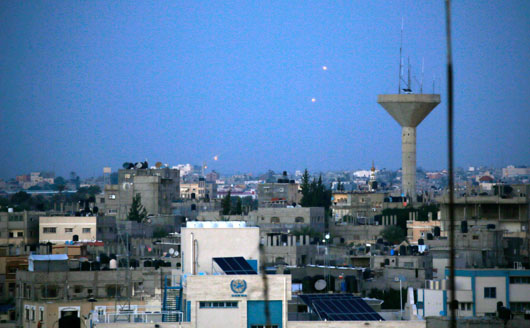Special to WorldTribune.com
The Israel-Arab peace effort is suddenly exploding.
But whether all this movement will usher in the Trump Administration’s promise “of a peace of the century” is another question.

After a year’s discussions led by Trump’s Jewish son-in-law, Jared Kushner, the Administration Special Mideast representative, the president’s design is supposedly ready.
But how to break through this hundred-year-old tangled ethnic, linguistic, living standard, diplomatic knot?
One speculation is that it will be called “a final settlement” rather than the step-by-step U.S.-led negotiations for over almost two decades, run for the most part by former Secretary of State Henry G. Kissinger. [In Singapore, the 95-year old Kissinger turned his attention at an international conference to the troubled China-U.S. relationship – on which he expressed “optimism”.]
Trump’s December 2017 implementation of Congress’s long-standing demand — and statements by earlier presidents endorsing the move — that the U.S. recognize Jerusalem as Israel’s capital set the diplomatic ball bouncing.
But as the left-wing Israeli newspaper Haaretz reports: “Saudi Arabia has informed U.S. President Donald Trump’s administration that it will not be able to support its peace plan … if it does not state that East Jerusalem would be the capital of the Palestinian state.”
Washington’s European allies oppose the deal, too, since they see it as American support for a maximalist, unilateralist agenda of Israeli Prime Minister Benjamin Netanyahu. [Netanyahu has a long-standing friendship with Charles Kushner, father of Ivanka Trump’s husband, Jared. In recent years, the Kushners, Orthodox Jews, made a fortune in real estate.]
Saeb Erekat Saeb Erekat, the PLO’s chief negotiator, also presented his leadership with a Washington hostile diplomatic landscape. The report supports Abbas in shunning America’s efforts after Trump’s Jerusalem Declaration.
“The relationship with the United States,” Erekat’s noted, “can only be sustained by the cancellation of the decision to consider Jerusalem as the capital of Israel and to cancel the decision to consider the PLO as an organization of terror.
“President Trump’s administration will not do either of these two things, so [the PLO] must stick to the suspension of all contacts with President Trump’s administration … refusing to regard it as mediator or sponsor of the peace process in any way.”
The fact is that “the two-state solution” which foresees the creation of a viable Palestinian Arab entity to match the already firmly-established, and now formally, Jewish State of Israel, is turning into three states.
Two Palestinian candidates for opposing Israel are lining up.
The first if of course the Palestinian Authority [PA] and its president, Mahmoud Abbas, firmly established in Ramallah on the so-called West Bank.
Israeli military and civilian occupation dominate the area, west of the Jordan River — excluding both West and traditionally Arab East Jerusalem — since The Six-Day War [1967]. But the Israelis have permitted growing self-government. [The regime has won recognition from the huge Third World presence at the UN General Assembly.] [Abbas has not been in Gaza in more than a decade, and his chances of returning there are poor because of his claim to represent all Palestinians.].
However, over the past few years, a fierce battle has taken place over the number of Palestinians living in the so-called Occupied Territories. The conservative American-Israel Demographic Research Group has tried for years to prove that the Palestinians, with great sophistication, have inflated their true population by 1 million people, and that the real figure currently stands at about 1.5 million people.
Meanwhile, in the so-called Gaza Strip, an area stretching from Israel proper along the Mediterranean Sea to Egypt with two-million Arabs has emerged. After the 1967 victory, Prime Minister Ariel Sharon pulled Israeli military out of Gaza in August, 2005, forcing Jewish “settlers” to “voluntarily” vacate. For Israeli hawks, Hamas [an Arabic acronym for the Islamic Resistance Movement], growing military strength and attacks on the southern Israeli border is “proof” that any future Palestinian state would be a threat to Israel. In fact, Israel continues to maintain direct external air and maritime control, control of six of Gaza’s seven land crossings, a no-go internal buffer zone, and a population registry. Gaza also remains dependent on Israel for water, electricity, telecommunications, and other utilities.
Hamas and Fatah have not been able to implement repeated “reconciliation” agreements. Fatah claims that the agreements are supposed to allow it full Gaza responsibility. Hamas vehemently refuses to relinquish security.
Last week Hamas began paying thousands of its employees after the oil-rich Gulf state of Qatar sent a $15 million cash grant, part of $90 million pledged by the Emirate. [The money was brought to Gaza by senior Qatari envoy Mohammed El-Amadi through the Israeli Erez border crossing.] [Earlier, despite its Muslim Brotherhood [ultra-Sunni] origins, Gaza was receiving Iranian [Shia] support – refuting another Mideast cliché on Sunni-Shia relations].
The Qatari grant is part of efforts by Egypt, Qatar, and the United Nations to promote a long-term truce between Israel and Hamas. In Ramallah, Palestine Authority’s Abbas opposes the truce accord between Israel and Hamas which he sees as possibly paving the way for the establishment of a separate Gaza Palestinian state.
Sol W. Sanders, ([email protected]), is a contributing editor for WorldTribune.com and Geostrategy-Direct.com.

